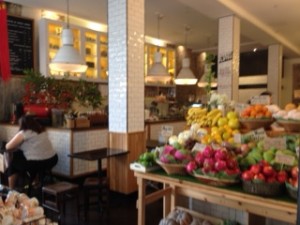Thai Food: Talking, Walking, Eating, Writing
by Jan

This was a 6 hour walking and tasting tour of Thai Town, Sydney, on Saturday 30 January 2016, led by Nuch, a member of the Thai community who works with Taste Food Tours. It was also in conjunction with the WEA, the writing part being delivered by Jeannette Delamoir who has extensive qualifications and experience in writing. She also has a particular interest in food.
My first experience of Thai food was when I was working as a cook in the 80’s at the Bayswater Brasserie. Thai food was starting to be popular in Sydney, so they put red Thai Chicken Curry on the menu, where it stayed, surviving many menu changes. I used to sneak a tiny bit in a cup and eat it with a teaspoon. It was excellent, and I quickly became addicted.
I think it was predominantly the umami and saltiness provided by the fish sauce, but also the lime leaf, galangal, and coconut milk which clinched it.
Back in the early ‘80s we were hard-pressed to buy any Thai ingredients. This was because the focus was on Italian and French cuisines which rose to prominence in the ‘60s. French cuisine involves more complicated culinary techniques, therefore slower, more expensive, and not quite so good for take-away.
This resulted in me cooking Thai at home, along with Thai beef salad; eating out at Thai restaurants; and constantly referring to Charmaine Solomon’s Asian Cookery to find out what else I could cook.
Boon Café is where we convened first thing in the morning. Some of us had a “green drink” which is a beautiful smoothie. Nuch, our tour guide, handed around tamarind sweets. They were salty, sweet and sour; three of the five flavours, the others being bitter and umami. These flavours come into play again with green mango salad: lime juice for acidity, palm sugar for sweetness, fish sauce for saltiness and umami. Along with the crunchiness of the grated mango and roasted peanuts.
At lunch (Mr B’s, corner of Goulburn St) Nuch, asked the group how much chilli we could tolerate, from “pre-school” (not much) to “university” (extremely hot). This reminded me of a stopover in Bangkok, where I went to have lunch in a local restaurant. I ordered Pad Thai, “not too hot please”. Well, for me, it was “university” level! My palate was relatively undeveloped as far as chilli heat is concerned; to me, this seemed off the Scoville chart!
Next stop was Khao San for desserts, where we also had extreme flavours, but not with chilli.
We sampled small squares of various desserts of extreme sweetness, extreme blandness, and eggy custardy softness. One was tapioca topped with a mildly salty coconut cream. That would have been lovely combined with a sharpish fruit salad of mango, pineapple and lime juice.
Later we adjourned to the WEA where we focused on the writing component. We were shown a short video of Amy Chant and her daughter, who run the Chat Thai restaurants, including Boon Café. And we were given a hand-out of articles about Thai food. One was a photocopy about Pad Thai, with a recipe. Pad Thai could be considered our first introduction to Thai cuisine; it’s available in every Thai restaurant.
Of course, from an Australian perspective, the Michelin-starred Thai food expert, David Thompson is someone whom we think of. A couple of articles were included about him.
What is interesting is that some chefs grew up with mothers who were not good cooks. Luckily, I didn’t have this misfortune. Maybe this causes potentially keen cooks to explore what good food should taste like.
Conventionally, learning to cook means learning French techniques because they are part of the traditional canon. Then the next step is to start tasting other cuisines which is what I did when I started cooking at the Bayswater Brasserie – see first paragraph above.
Even though David Thompson is long gone from the Darley Street Thai, it still operates under different management, and still serving excellent dishes. So does Amy Chant at her Chat Thai chain.